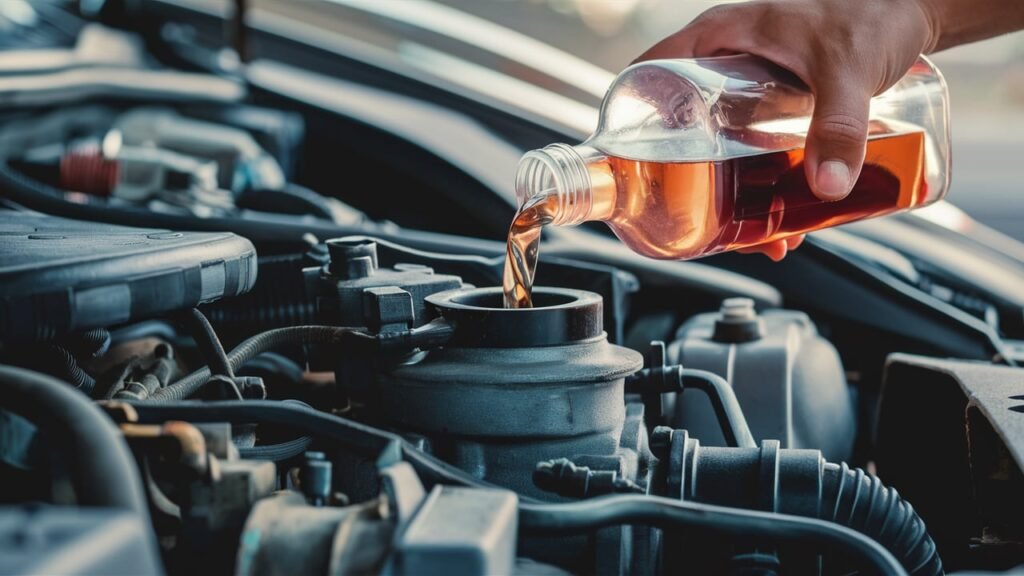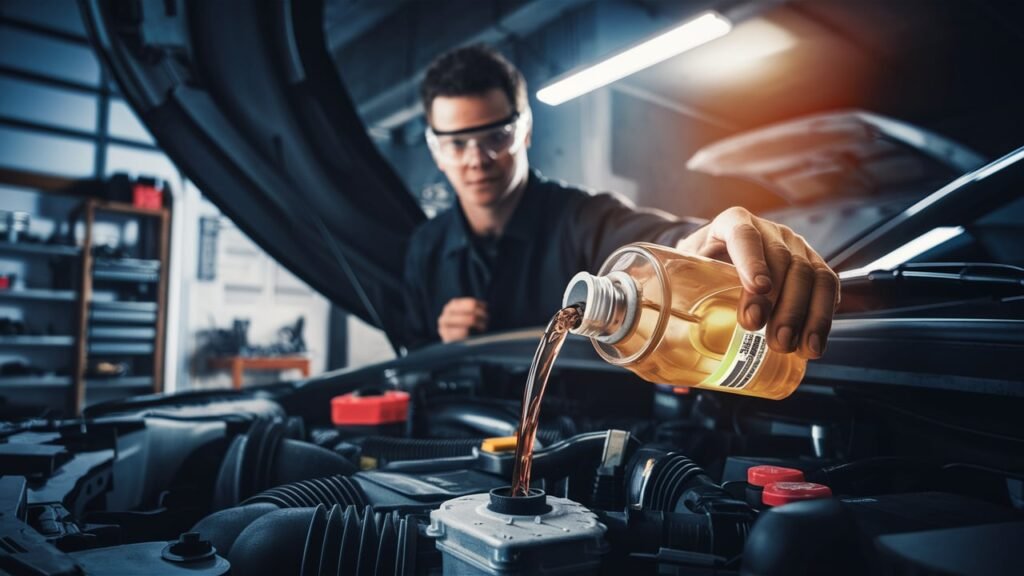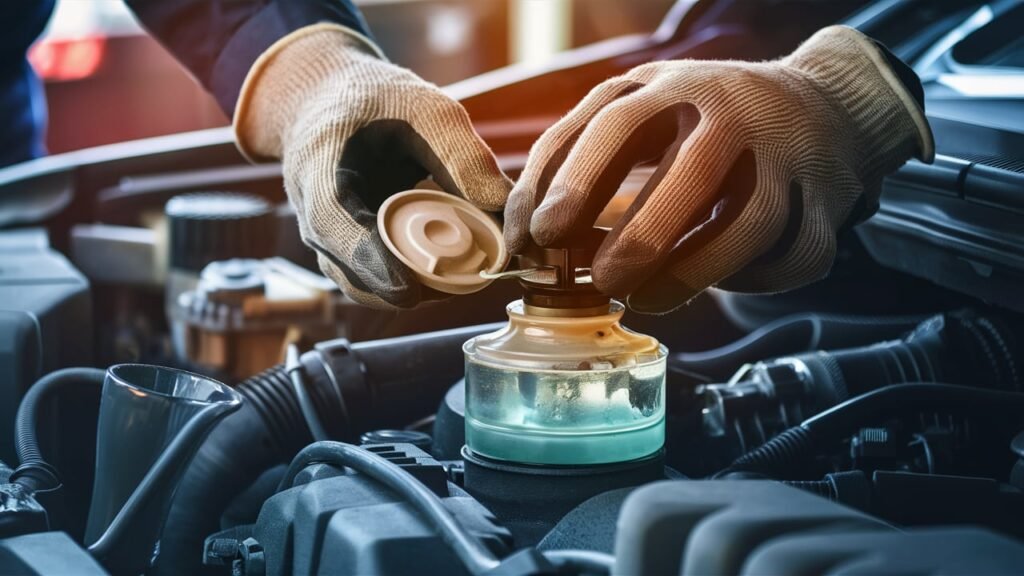
Everything You Need to Know About Car Engine Coolant Fluid
Car engine coolant fluid, also known as antifreeze, is a mixture of water and antifreeze chemicals that helps regulate the temperature of an engine and its components. It is typically composed of 50% water and 50% ethylene glycol or propylene glycol, with additional additives for corrosion protection and lubrication. The coolant fluid serves several purposes:
Temperature Regulation: It helps to lower the freezing point and raise the boiling point of water, allowing the engine to function in a wider range of temperatures. This ensures that the engine does not overheat or freeze, which can cause damage or even engine failure.
Heat Absorption and Dissipation: The coolant absorbs heat from the engine and transfers it to the radiator, where it is dissipated into the air. This process helps to maintain a consistent engine temperature, which is essential for optimal performance and to prevent overheating. Corrosion Protection:
Coolant contains rust and corrosion inhibitors that help protect the engine and its components from rust and corrosion caused by extreme temperatures and chemicals found in the air. Lubrication: Coolant also provides some lubrication to the engine components, which helps to reduce friction and wear.
Overall, engine coolant is a crucial component in maintaining the health and performance of a vehicle’s engine, and it is essential to use the correct type and to check its level regularly to ensure proper functioning.
Car engine coolant fluid, a seemingly humble component within the intricate machinery of a vehicle, plays a vital role in ensuring optimal performance and longevity of your automobile. As the lifeblood that regulates engine temperature, this fluid quietly prevents catastrophic overheating or freezing scenarios with precision.
Understanding the nuanced composition and functioning of coolant is not merely for the automotive aficionado but an essential knowledge domain for every car owner. This comprehensive guide delves into the depths of car engine coolant fluid, demystifying its core essence and equipping you with the insights necessary to navigate the complex terrain of vehicle maintenance effectively.
Embark on a journey through the inner workings of your car’s cooling system as we unravel the mysteries surrounding coolant fluid. Meandering through the labyrinthine structure of an automobile’s anatomy reveals how this unassuming liquid interacts with sophisticated components such as radiators, water pumps, and thermostats to uphold the delicate balance of thermal equilibrium.
Gone are the days when grasping at vague notions sufficed; arm yourself with practical wisdom about different types of coolants – from organic acid technology (OAT) to hybrid organic acid technology (HOAT) – and steer clear of pitfalls stemming from ignorance. Delve deeper into these scientific intricacies as we decode each facet methodically in this comprehensive discourse on all things related to car engine coolant fluid.
Understanding Car Engine Coolant Fluid.
Car engine coolant fluid, often simply referred to as coolant or antifreeze, is a specially formulated liquid that plays a crucial role in maintaining the optimal temperature of a vehicle’s engine.
Its primary function is to regulate the engine temperature by absorbing excess heat generated during combustion and dissipating it through the radiator. This process is essential for preventing overheating, which can lead to costly internal damage to the engine components.
Coolant fluid works not only to prevent overheating but also to protect the engine from freezing in cold temperatures. By lowering the freezing point of water, coolant ensures that the engine’s cooling system remains functional even during extreme weather conditions. This dual functionality of coolant makes it indispensable for ensuring smooth and efficient operation of vehicles regardless of environmental factors.
To illustrate, imagine driving your car through a scorching summer day. As you drive, the engine produces significant amounts of heat due to combustion processes. Without coolant fluid circulating through the system, this heat would quickly build up and cause the engine to overheat, potentially leading to catastrophic failure.
Conversely, in winter months where temperatures drop below freezing, coolant prevents water in the system from solidifying and damaging vital components like the radiator or water pump. In essence, understanding how coolant functions is fundamental for every vehicle owner to appreciate its critical role in preserving their vehicle’s performance and longevity.
Types of Coolant Fluids.
Car engine coolant fluids come in various types, each designed with specific compositions to cater to different vehicle requirements. Understanding the distinctions between organic acid technology (OAT), inorganic acid technology (IAT), and hybrid organic acid technology (HOAT) coolants is crucial for maintaining optimal engine performance.
OAT coolants, often recognized by their extended lifespan and compatibility with aluminum engines, contain additives like sebacate or 2-EHA that offer improved corrosion protection. While advantageous in some aspects, OAT coolants may not be universally compatible with all vehicles due to their chemical composition.
Conversely, IAT coolants are more traditional and utilize inorganic additive packages like silicate or phosphate. These coolants provide effective protection against cavitation erosion but might require more frequent changes compared to advanced OAT equivalents.

Additionally, IAT coolants are suitable for older vehicle models without the intricate cooling system designs necessitated by newer engines. HOAT coolants combine attributes from both OAT and IAT formulations, blending organic acids with conventional inorganic inhibitors for a balanced approach to corrosion prevention and longevity.
When selecting the appropriate coolant type for your vehicle, it is essential to consider factors such as the manufacturer’s specifications and the age of the car. For instance, newer models designed with aluminum components may benefit from using OAT coolant for enhanced protection against corrosion, while older vehicles could thrive on IAT formulations that align better with their cooling system requirements.
Regularly consulting with your vehicle manual or a trusted mechanic can help determine the most suitable coolant fluid based on your specific driving conditions and maintenance preferences.
Signs Your Car Needs Coolant Replacement.
When it comes to maintaining your vehicle’s cooling system, being able to recognize the signs that indicate a need for coolant replacement is crucial. One common symptom of low coolant levels or degraded fluid quality is overheating.
If you notice that your engine temperature gauge is consistently running higher than normal or if you observe steam coming from under the hood, it could signal a coolant issue. Ignoring these warning signs can lead to severe engine damage due to overheating.
Another indicator that your car might need a coolant replacement is a sweet smell inside the cabin or around the engine bay. This smell is often associated with leaking coolant, which can be caused by a variety of issues such as a cracked radiator or a faulty hose. Additionally, if you see visible coolant leaks on the ground where you park your car, it’s essential to address the problem promptly to prevent further damage.
Driving with insufficient or deteriorated coolant can have serious consequences on your vehicle’s performance and longevity. Without adequate coolant, your engine can overheat, leading to warped cylinder heads or even complete engine failure.
Moreover, neglected coolant maintenance can result in corrosion within the cooling system components, reducing their efficiency and potentially causing leaks. It is critical to address any signs indicating the need for coolant replacement promptly to avoid costly repairs down the line.
How to Check Coolant Levels.
To ensure your vehicle’s engine operates at the correct temperature, regularly checking coolant levels is essential. Here is a step-by-step guide to safely and accurately check the coolant levels in your car:
1. **Safety First:** Before opening the hood, make sure the engine has cooled down completely to prevent any burns. It’s advisable to check the coolant when the engine is cold or has been off for some time.
2. **Locate the Coolant Reservoir:** Pop open the hood of your car and locate the coolant reservoir tank. This translucent container usually has markings indicating minimum and maximum levels. Ensure that the coolant level falls between these markers.

3. **Check the Color and Consistency:** Observe the coolant’s color through the transparent tank. Fresh coolant is typically brightly colored (green, orange, pink, blue), while degraded fluid may appear murky or contain floating particles. Additionally, ensure that it has a consistent texture without any oil slicks on its surface.
4. **Top Up When Necessary:** If you notice that the coolant level is below the minimum mark, it’s time to top up with a compatible coolant blend recommended for your vehicle by consulting your owner’s manual.
Regularly monitoring your vehicle’s coolant levels not only helps maintain optimal engine performance but also prevents potential overheating issues that could lead to costly repairs down the road. By following these simple steps, you can keep your engine running smoothly and efficiently.
Flushing and refilling.
The process of flushing and refilling coolant in a car is essential to maintain the health of the engine and ensure optimal performance. When it comes to DIY maintenance, understanding the steps involved is crucial to avoid costly repairs down the road.
To begin, park the vehicle on level ground and let the engine cool completely before starting any work. Locate the radiator cap and carefully release any pressure by turning it counterclockwise allowing excess heat to escape.

Next, identify the drain plug at the bottom of the radiator; place a container underneath to catch the old coolant as it drains out. Once all the old fluid has been extracted, tighten back the drain plug securely.
With that done, the next step involves refilling with fresh coolant. It’s important to use a mixture of distilled water and coolant in the appropriate ratio recommended for your vehicle—usually 50/50 but consult your owner’s manual for accuracy.
During this process, be mindful not only about efficiently completing each step but also about environmental considerations. Antifreeze should not be allowed to spill on surfaces or into drains due to its toxicity to wildlife and harmful environmental impact.
If DIY tasks seem overwhelming, considering seeking professional assistance can ease any concerns and ensure that every aspect of your coolant system is handled correctly by knowledgeable experts who have access to specialized equipment.
When handling coolant-related tasks yourself or entrusting them to professionals, thoroughness is key in maintaining an efficient cooling system. By following these outlined steps diligently with attention to detail, you can keep your engine running smoothly while adhering to best practices for prolonging its lifespan through proper care and maintenance protocols.
Maintaining proper coolant levels.
Maintaining proper coolant levels in your vehicle is essential for ensuring optimal engine performance and preventing potentially costly repairs. Between scheduled coolant flushes, it’s crucial to monitor the level of coolant in your car regularly.
One way to do this is by visually inspecting the coolant reservoir when the engine is cool. The reservoir typically has markings indicating the minimum and maximum levels, allowing you to gauge whether your coolant needs a top-up.

To maintain proper coolant levels effectively, it’s advisable to use a mix of distilled water and coolant designed for your specific vehicle make and model. When adding more coolant, ensure you follow the manufacturer’s recommendations regarding dilution ratios to prevent issues like overheating or poor heat transfer within the engine. Keeping a bottle of premixed coolant in your trunk can be handy for emergencies or quick top-ups on-the-go.
Common issues related to maintaining proper coolant levels can arise from leaks in the cooling system. Inspect hoses, connections, and the radiator for signs of leakage regularly to address any potential problems promptly.
Additionally, monitoring your car’s temperature gauge while driving can alert you to any sudden drops or spikes that may indicate a cooling system issue requiring immediate attention. Taking preventive measures when it comes to maintaining coolant levels can significantly extend the lifespan of your vehicle’s engine and cooling components.
Importance of Using Recommended Coolants.
Using the manufacturer-recommended coolant for your specific vehicle model is crucial for maintaining optimal engine performance and longevity. Each type of coolant is specifically formulated to suit the materials and components of a particular engine, ensuring proper lubrication, corrosion protection, and heat transfer properties. Deviating from the recommended coolant can lead to issues such as accelerated corrosion, ineffective heat dissipation, or even damage to engine parts over time.
For instance, if a vehicle that requires an OAT coolant is filled with an IAT coolant instead, the differences in chemical composition could result in poor heat transfer efficiency.
This mismatch may cause the engine to operate at higher temperatures than intended, potentially leading to overheating and subsequent engine damage. Similarly, using a HOAT coolant in a system designed for an IAT coolant could compromise corrosion protection and cooling performance due to incompatible additives.
Furthermore, manufacturers conduct extensive research and testing to determine the best coolant formulations for their engines based on material compatibility and performance requirements.
Ignoring these recommendations might seem like a cost-saving measure initially but can ultimately result in expensive repairs or premature engine failure. By adhering to the prescribed coolant types, car owners can ensure that their vehicles operate smoothly and efficiently while maximizing the lifespan of critical engine components.
Cooling System Components Explained.
The cooling system in your vehicle is a complex network of components working together to maintain the engine temperature within optimal limits. Key elements include the radiator, water pump, thermostat, hoses, and the coolant itself. The radiator acts as a heat exchanger that helps dissipate heat generated by the engine. It consists of small tubes through which coolant flows while air passes over them to cool down the liquid.
The water pump is responsible for circulating the coolant throughout the engine and radiator. It ensures that the coolant absorbs heat from the engine components and releases it in the radiator to be cooled down.
The thermostat acts as a gatekeeper, regulating the flow of coolant based on temperature. When the engine reaches its operating temperature, the thermostat opens up to allow circulation of coolant. If it’s too cold or hot, it remains closed to prevent overheating or inefficient warming during startup.
Hoses connect these components and facilitate the movement of coolant between them. They need to be in good condition to prevent leaks or blockages that can disrupt the cooling process.
Each part plays a crucial role in maintaining an ideal operating temperature for your engine. Understanding how these components work together can help you diagnose cooling system issues effectively and ensure that your vehicle runs smoothly without any overheating concerns.

How Often Should I Check My Engine Coolant Level?
It is recommended to check your engine coolant level regularly to ensure that it is at the proper level and to prevent overheating or damage to your engine. The frequency of checking depends on the type of vehicle and the driving conditions:
- Typical Schedule: Check the coolant level every 3,000 to 5,000 miles (4,800 to 8,000 km) or every 3 to 6 months, whichever comes first.
- Severe Driving Conditions: If you drive in extreme temperatures, tow a trailer, or drive in stop-and-go traffic, you should check the coolant level more frequently, every 1,000 to 2,000 miles (1,600 to 3,200 km).
What Are the Signs That My Engine Coolant is Low?
If your engine coolant level is low, you may notice the following signs:
- Coolant Level Indicator: Check your vehicle’s owner’s manual for the coolant level indicator. It is usually a dipstick or a gauge on the dashboard.
- Overheating: If your engine is overheating, it can cause the temperature gauge on your dashboard to rise. This is a sign that the coolant level is low.
- Leaks: Look for signs of leaks around the radiator, hoses, and water pump. If you notice any leaks, it is essential to address them promptly to prevent further damage.
Can Using the Wrong Type of Coolant Damage My Engine?
Yes, using the wrong type of coolant can cause significant damage to your engine. Here are some potential risks:
- Incompatibility: Using coolant that is not designed for your vehicle’s engine can cause corrosion, damage to engine components, and even engine failure.
- Freezing: Using coolant that is not designed for your vehicle’s climate can cause the coolant to freeze, leading to engine damage or failure.
- Boiling: Using coolant that is not designed for your vehicle’s climate can cause the coolant to boil, leading to engine damage or failure.
It is crucial to use the correct type of coolant for your vehicle, as specified in the owner’s manual. If you are unsure, consult with a mechanic or the manufacturer for guidance.
Conclusion: Ensuring Longevity Through Proper Coolant Care.
In conclusion, the proper care and maintenance of car engine coolant fluid are paramount to the longevity and optimal performance of a vehicle’s cooling system. By understanding the types of coolant fluids available, recognizing the signs that indicate the need for replacement, and diligently monitoring coolant levels, car owners can effectively safeguard their engines against overheating or freezing issues.
Regular flushing and refilling of coolant, following manufacturer recommendations for the appropriate coolant type, and keeping all cooling system components in good working order are essential steps in ensuring a healthy engine.
By following best practices in coolant care outlined in this comprehensive guide, car owners can extend the lifespan of their vehicles and prevent costly repairs due to cooling system malfunctions.
Consistent maintenance of coolant fluid not only helps regulate engine temperature but also contributes to overall vehicle efficiency and reliability. Remember, when it comes to your car’s engine coolant fluid, attention to detail and adherence to recommended practices will go a long way in preserving the health of your vehicle’s vital systems.




